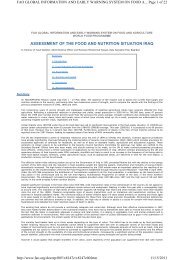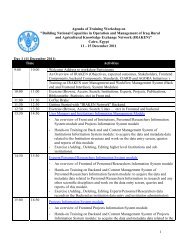Vermiculture in Egypt: - FAO - Regional Office for the Near East and
Vermiculture in Egypt: - FAO - Regional Office for the Near East and
Vermiculture in Egypt: - FAO - Regional Office for the Near East and
Create successful ePaper yourself
Turn your PDF publications into a flip-book with our unique Google optimized e-Paper software.
How long will <strong>the</strong> material <strong>in</strong>gested by <strong>the</strong> compost worm be <strong>in</strong> his gut?<br />
In adult compost worms (Eisenia <strong>and</strong>rei) appr. 3 to 4 hours, <strong>in</strong> juvenile worms appr.<br />
11 to 13 hours. The scientists expected <strong>the</strong> opposite (a longer retention time <strong>for</strong> adult<br />
worms).<br />
For Eisenia foetida 2.5 h were measured at 25°C, <strong>in</strong>dependent from <strong>the</strong> weight or <strong>the</strong><br />
length of <strong>the</strong> worm. At 18°C <strong>the</strong> retention time was about 3.5 hours.<br />
Lumbricus terrestris shows a retention time of 20 hours. O<strong>the</strong>r worm species 11 to 13<br />
hours (Lumbricus festivus, Lumbricus rubellus, Allolobophora calig<strong>in</strong>osa).<br />
How do compost worms multiply?<br />
Like all earthworms, compost worms have female <strong>and</strong> male gender organs<br />
(hermaphrodite). If <strong>the</strong>y pair off, <strong>the</strong> genitals come mutually to narrow contact. These<br />
are localized <strong>in</strong> <strong>the</strong> wide r<strong>in</strong>gs (clitellum) of adult worms. This r<strong>in</strong>g walks <strong>in</strong> <strong>the</strong><br />
course of <strong>the</strong> next days on <strong>and</strong> on to <strong>the</strong> back <strong>and</strong> is shored up, <strong>in</strong> <strong>the</strong> end, so that a<br />
yellowish cocoon orig<strong>in</strong>ates which has <strong>the</strong> <strong>for</strong>m a lemon. After a certa<strong>in</strong> time, out of<br />
this small mites are slipp<strong>in</strong>g.<br />
How often does a conception take place with <strong>the</strong> mat<strong>in</strong>g of compost worms?<br />
It comes to 61% of <strong>the</strong> mat<strong>in</strong>gs to <strong>the</strong> transfer of sperm. Of it a mutual transfer of<br />
sperm takes place <strong>in</strong> 88.2% of <strong>the</strong> cases, <strong>in</strong> 9.8% <strong>the</strong> transfer occurred only <strong>in</strong> one<br />
direction. Merely <strong>in</strong> one case a self conception occurred.<br />
Is a self-fertilization also possible with compost worms?<br />
Although reported very often with earthworms, a self-sperm transfer could be clearly<br />
documented <strong>in</strong> 2003 <strong>for</strong> <strong>the</strong> first time. This occurs very seldom <strong>and</strong> was observed with<br />
Eisenia foetida. Self conception is an extreme <strong>for</strong>m of <strong>in</strong>breed<strong>in</strong>g. The genetic<br />
diversity is lowered what normally leads to a reduction <strong>in</strong> fitness of <strong>the</strong> species. For<br />
this reason mechanisms of self-<strong>in</strong>compatibility have been developed <strong>in</strong> many species.<br />
Which compost worm multiplies faster? Eisenia foetida or Eisenia <strong>and</strong>rei?<br />
Scientific <strong>in</strong>vestigations from <strong>the</strong> year 2003 showed that Eisenia <strong>and</strong>rei multiplies<br />
much faster under <strong>the</strong> elective conditions of <strong>the</strong> study. The percentage of <strong>the</strong> worms,<br />
that produced cocoons was substantially higher (33% compared with 3.5%). Also <strong>the</strong><br />
number of <strong>the</strong> produced cocoons was higher with Eisenia <strong>and</strong>rei, likewise <strong>the</strong> slip rate<br />
of <strong>the</strong> mites from <strong>the</strong> cocoons. The life ability of <strong>the</strong> cocoons was possibly equally<br />
high with both species.<br />
86





